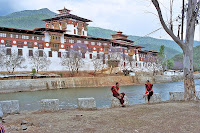 Pungtang Dechen Photrang Dzong or Punakha Dzong was constructed by Zhabdrung Ngawang Namgyal in 1637-38. It is the winter home of Bhutan's Central Monastic Body led by HH the Je Khenpo. The Dzong houses the most sacred relics of the Southern Drukpa Kagyu school including the Rangjung Kasarpani, and the sacred remains of Zhabdrung Ngawang Namgyal and Terton Padma Lingpa.
Pungtang Dechen Photrang Dzong or Punakha Dzong was constructed by Zhabdrung Ngawang Namgyal in 1637-38. It is the winter home of Bhutan's Central Monastic Body led by HH the Je Khenpo. The Dzong houses the most sacred relics of the Southern Drukpa Kagyu school including the Rangjung Kasarpani, and the sacred remains of Zhabdrung Ngawang Namgyal and Terton Padma Lingpa.In 1907, Punakha Dzong was the site of the coronation of Ugyen Wangchuck or Deb Nagpo as the first King of Bhutan. Three years later, a treaty was signed at Punankha whereby the British agreed not to interfere in Bhutanese internal affairs and Bhutan allowed Britain to direct its foreign affairs. In 1987, the dzong was partially destroyed by fire.
Due to its location at the confluence of the Pho Chhu and Mo Chhu rivers in the Punakha-Wangdue valley, the dzong is vulnerable to flash flooding caused by glacier lakes. According to a recent report, flash flood damage to Punakha Dzong occurred in 1957, 1960 and 1994. A covered wooden cantilever bridge crossing the Mo Chhu river was built together with the Dzong in the 17th century. This bridge was washed away by a flash flood in 1957 or 1958. In 2006 work started on a new covered wooden cantilever bridge of traditional construction with a free span of 55 meters which was completed in 2008.


Punakha valley is famous in Bhutan for rice farming. The red and white rice are grown beside the river valley of Pho and Mo Chu which is the most prominent rivers in Bhutan. Ritsha which means at the base of a hill is a classic village in Punakha. The village houses are made of crushed mud with stone foundations. Each house is only two storeys high. Surrounding the houses are the gardens and the rice fields. The gardens also usually have fruit bearing plants like oranges and papaya among the organic vegetables. In the recent years, the farming work is mechanized and power-tillers instead of bullocks are used to plough the fields and villagers have become relatively properous. This is a model rice growing village in western Bhutan.







No comments:
Post a Comment